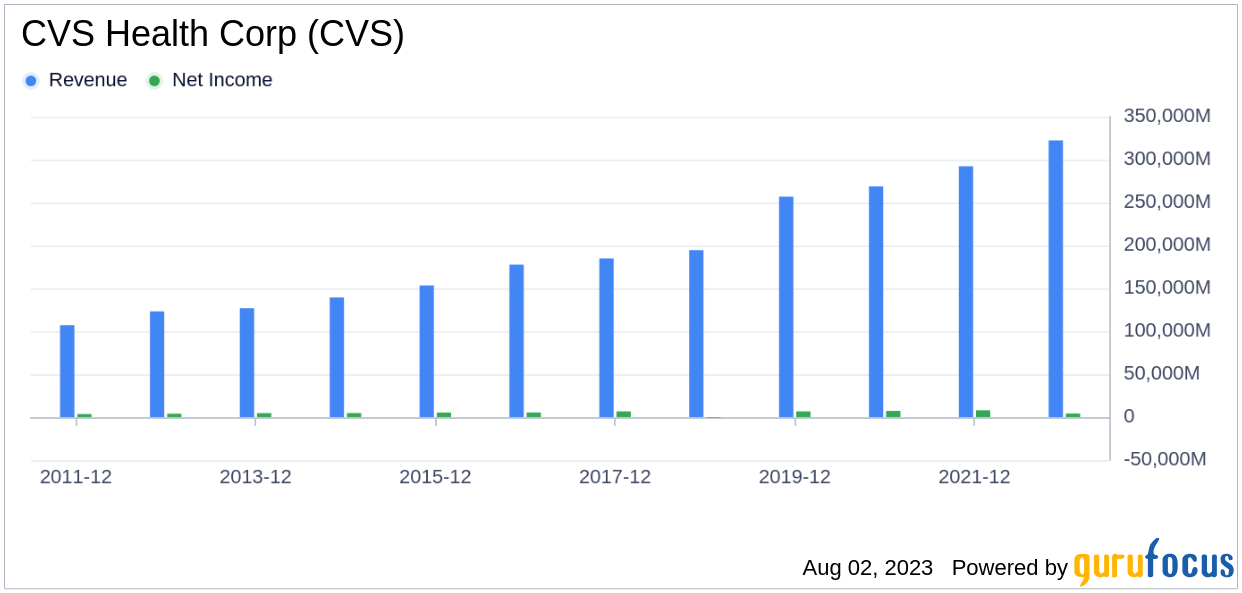In a recent earnings call, CVS Health Corp. (CVS, Financial) President and CEO Karen Lynch and Chief Financial Officer Shawn Guertin discussed various strategies and opportunities that could potentially mitigate headwinds and drive growth in the coming years. Several analysts posed questions to the company's executives regarding various aspects of the business. The management team, led by Lynch, provided insightful answers, shedding light on the company's strategies and future prospects.
Strategies and opportunities from the CEO and CFO
Guertin emphasized the company's commitment to achieving adjusted earnings per share targets of $9 for 2023 and approximately $10 for 2024. He acknowledged the existence of certain headwinds, particularly related to Stars and Centene, but expressed confidence in the organization's ability to overcome them. He highlighted two key levers that could help mitigate these challenges.
The first lever involves exploring alternatives to accelerate growth and synergy realization in Signify and Oak Street. For Signify, CVS plans to leverage its combined assets to expand product offerings and capabilities for all payers, driving continued strong multi-payer growth. With the early closing of the Oak Street acquisition, CVS aims to explore alternative growth vehicles that would allow it to accelerate clinic growth and minimize dilution. Guertin emphasized the importance of starting this work well in advance of 2024 to maximize its impact.
Furthermore, the closing of these strategic transactions and the resegmenting of CVS Health's operations provide an opportunity to improve focus, reduce administrative and operational costs and achieve greater organizational efficiency. By streamlining processes, eliminating duplicative efforts and enhancing operational efficiency, CVS expects to realize significant cost savings. These cost reductions are expected to serve as mitigating tailwinds for 2024 and 2025, further supporting the company's earnings goals.
During the call, Guertin also addressed the concept of embedded Ebitda, which refers to the long-term value generated by accelerating clinic growth. While the GAAP financials may not fully capture this embedded Ebitda, he emphasized its significance and the potential for models and vehicles that could both accelerate clinic growth and better manage the dilutive impact. With the early closing of the Oak Street acquisition, CVS Health now has the opportunity to explore and potentially execute on these models, aiming to have a positive impact on 2024 earnings.
Addressing analysts' questions
One of the questions came from Michael Cherny of Bank of America, who sought clarification on the segmentation change within CVS. Cherny inquired about the movement of specialty and mail revenue and Ebit from Health Services to Pharmacy and Consumer Wellness. Lynch confirmed the change and emphasized the importance of understanding the full context of the guidance shift. Additionally, she addressed the impact of the 340B program on Health Services and Pharmacy and Consumer Wellness, highlighting the need for bridging the total numbers.
Lisa Gill from JPMorgan commended the company on its performance in the pharmacy benefit management industry, but raised concerns about potential changes in the sector. Lynch acknowledged the critical role played by PBMs in lowering drug costs and emphasized the efficiency and effectiveness of CVS's PBM operations. She highlighted the company's commitment to transparency and innovation, as well as its clients' ability to choose how they contract for rebates and spread pricing. Lynch also mentioned the high level of member and client satisfaction, as well as the government's recognition of the PBMs' contribution to the health care ecosystem.
Eric Percher of Nephron Research questioned Lynch about potential future acquisitions in the health care services sector. She acknowledged the possibility of considering additional assets in the long term, but emphasized the need to focus on executing the recently acquired assets. She mentioned the potential for opportunities in home or health services technology, but stressed the importance of bringing the current products and services to bear for customers.
Kevin Caliendo from UBS sought clarification on the second-quarter medical benefit ratio and utilization expectations. Geurtin confirmed that the second-quarter MBR would be flat compared to the first quarter. He mentioned that utilization expectations were in line with projections, with higher flu rates being a notable factor. However, he did not provide specific segment breakdowns for utilization expectations.
Albert Rice, an analyst from Credit Suisse, directed his questions toward the company's Medicare Advantage plans and the mitigation steps taken to offset Star Rating headwinds. Lynch expressed confidence in Oak Street Health's ability to adapt to pending changes in risk adjustment, highlighting their positioning relative to other options. Regarding the cost reduction programs, Guertin provided an update on the plan that was impacted, but specific details were not disclosed.
Conclusion
Overall, CVS Health's CEO and CFO expressed confidence in the company's ability to achieve its earnings targets and navigate potential headwinds. Through strategic initiatives, such as exploring growth opportunities in Signify and Oak Street, streamlining operations and managing clinic growth, the company aims to drive earnings growth and deliver value to its shareholders. Investors should be closely watching the company's progress as it executes on these strategies and works toward its financial goals.
The retail pharmacy company remains committed to executing its goals, delivering value to customers and navigating potential changes in the health care industry from companies like Amazon (AMZN, Financial). The focus on clinic growth seems well suited to CVS by focusing on the advantages of its existing brick-and-mortar locations. I expect the stock price to continue pace in line with very long-term trends.


